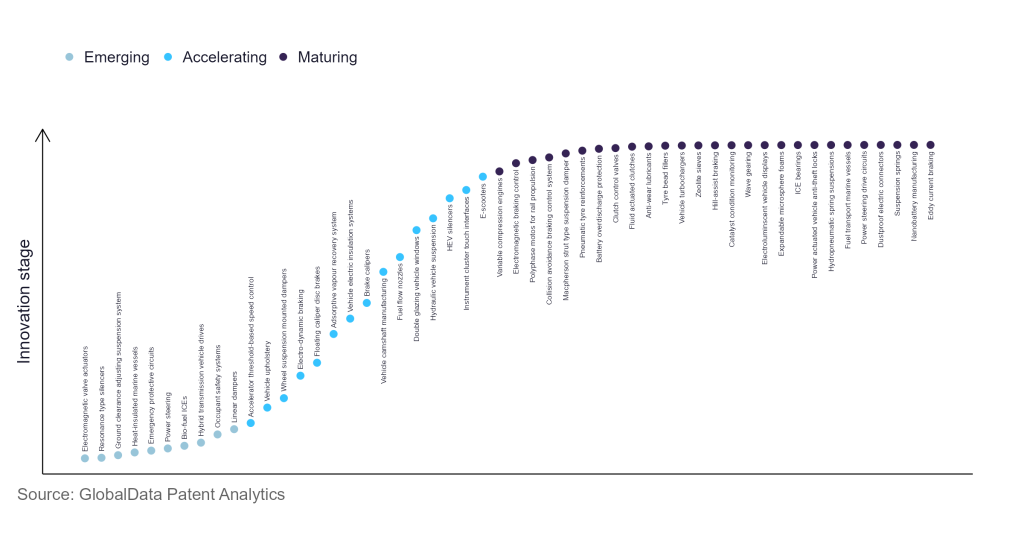The automotive industry continues to be a hotbed of innovation, with activity driven by the need for enhanced driving experience, fuel efficiency, and engine performance, and growing importance of technologies such as electrification, and connected and autonomous vehicles. In the last three years alone, there have been over 1.2 million patents filed and granted in the automotive industry, according to GlobalData’s report on Innovation in Automotive: Polysulphide batteries. Buy the report here.
However, not all innovations are equal and nor do they follow a constant upward trend. Instead, their evolution takes the form of an S-shaped curve that reflects their typical lifecycle from early emergence to accelerating adoption, before finally stabilising and reaching maturity.
Identifying where a particular innovation is on this journey, especially those that are in the emerging and accelerating stages, is essential for understanding their current level of adoption and the likely future trajectory and impact they will have.
290+ innovations will shape the automotive industry
According to GlobalData’s Technology Foresights, which plots the S-curve for the automotive industry using innovation intensity models built on over 619,000 patents, there are 290+ innovation areas that will shape the future of the industry.
Within the emerging innovation stage, resilient spoke wheels, auto-transmission lubrication circuits, and ignition switching engines are disruptive technologies that are in the early stages of application and should be tracked closely. Engine purge actuators, electro-dynamic braking, and adsorptive vapour recovery system estimation are some of the accelerating innovation areas, where adoption has been steadily increasing. Among maturing innovation areas are collision avoidance braking control system and direct injection type engines, which are now well established in the industry.
Innovation S-curve for the automotive industry

Polysulphide batteries is a key innovation area in automotive
Polysulfide bromide battery is a type of rechargeable electric battery created when sodium bromide and sodium polysulfide in two salt-solution electrolytes undergo a reversible electrochemical reaction. It stores electric energy in liquids, such as water-based solutions of two salts, and is used for medium and large-scale energy storage. Polysulfide flow batteries exhibit a relatively high energy density with the ultralow chemical cost of the redox-active materials.
GlobalData’s analysis also uncovers the companies at the forefront of each innovation area and assesses the potential reach and impact of their patenting activity across different applications and geographies. According to GlobalData, there are 20+ companies, spanning technology vendors, established automotive companies, and up-and-coming start-ups engaged in the development and application of polysulphide batteries.
Key players in polysulphide batteries – a disruptive innovation in the automotive industry
‘Application diversity’ measures the number of different applications identified for each relevant patent and broadly splits companies into either ‘niche’ or ‘diversified’ innovators.
‘Geographic reach’ refers to the number of different countries each relevant patent is registered in and reflects the breadth of geographic application intended, ranging from ‘global’ to ‘local’.
Patent volumes related to polysulphide batteries
| Company | Total patents (2021 - 2023) | Premium intelligence on the world's largest companies |
| Toyota Motor | 138 | Unlock Company Profile |
| Nippon Shokubai | 105 | Unlock Company Profile |
| Idemitsu Kosan | 98 | Unlock Company Profile |
| Emerson Electric | 59 | Unlock Company Profile |
| Mitsui Mining & Smelting | 50 | Unlock Company Profile |
| Mitsubishi Gas Chemical | 42 | Unlock Company Profile |
| Solvay | 42 | Unlock Company Profile |
| Hyundai Motor Group | 30 | Unlock Company Profile |
| LG | 24 | Unlock Company Profile |
| Kia | 24 | Unlock Company Profile |
| SES Holdings | 18 | Unlock Company Profile |
| BASF | 18 | Unlock Company Profile |
| Porsche Automobil Holding | 18 | Unlock Company Profile |
| Panasonic | 17 | Unlock Company Profile |
| Sumitomo Electric Industries | 13 | Unlock Company Profile |
| Central Glass | 11 | Unlock Company Profile |
| Toyota Jidosha Kogyo | 11 | Unlock Company Profile |
| CEA | 11 | Unlock Company Profile |
| Solid Power | 10 | Unlock Company Profile |
| Shin-Etsu Chemical | 10 | Unlock Company Profile |
| Fujifilm Holdings | 7 | Unlock Company Profile |
| CSL | 7 | Unlock Company Profile |
| Samsung Group | 7 | Unlock Company Profile |
| Toshiba | 7 | Unlock Company Profile |
| Centre National de la Recherche Scientifique | 6 | Unlock Company Profile |
| Murata Manufacturing | 5 | Unlock Company Profile |
| Sony Group | 5 | Unlock Company Profile |
Source: GlobalData Patent Analytics
Toshiba is one of the leading innovators in polysulphide batteries patents. The company develops, produces, and sells rechargeable polysulphide batteries, that have a long lifespan, recharge quickly, and function even in cold temperatures. The batteries are used in a variety of industries, including transportation, railroads, industrial machinery, automated guided vehicles, and even massive stationary power storage systems. Other companies innovating in this technology domain are LG, Panasonic, and Kia.
To further understand the key themes and technologies disrupting the automotive industry, access GlobalData’s latest thematic research report on Automotive.
Data Insights
From

The gold standard of business intelligence.
Blending expert knowledge with cutting-edge technology, GlobalData’s unrivalled proprietary data will enable you to decode what’s happening in your market. You can make better informed decisions and gain a future-proof advantage over your competitors.



